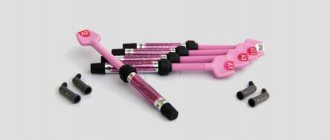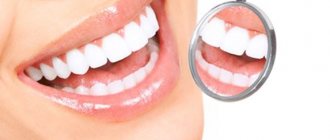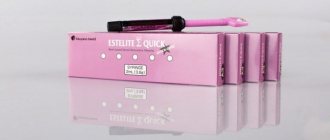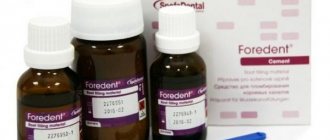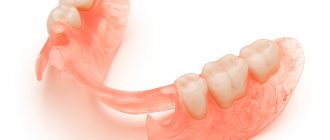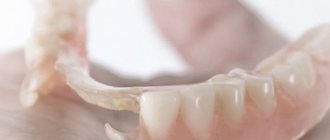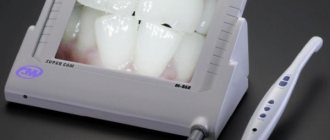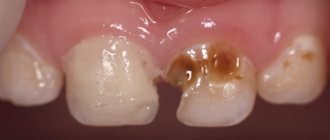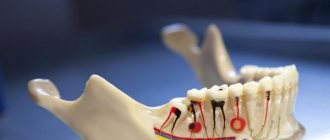8399
Those years when a visit to the dentist and the procedure for filling an affected tooth were the subject of physical and moral torment are far in the past.
Now, thanks to innovative scientific developments, high-quality and safe materials and modern equipment, monitoring the health of the oral cavity and promptly eliminating problems that arise has become comfortable and harmless.
This article will discuss the currently best filling material Estelite.
General overview
Estelite Sigma Quick is a modern composite mass, specially developed by Japanese specialists in the field of dental practice for filling teeth.
The drug is a universal set of elements characterized by radiopaque characteristics and excellent light-curing properties.
Combined with a high aesthetic factor and fast polymerization processes, the material has proven itself in clinics around the world, being one of the best products among its product range.
Composition and properties
A high-quality result and a high strength index are ensured due to excellent mechanical and physical characteristics due to the presence of all the constituent elements of the composite.
More than 80% of it consists of silicon-zirconium mass, which ensures minimal shrinkage of the material subsequently .
Choosing the right shade is quite easy - the product line includes about two dozen color options. The composition is perfectly polished, and the high-quality result lasts for a long period of time.
The mass is resistant to abrasion and has the highest wear resistance class.
In what clinical cases is the method of retrograde root canal filling justified?
Come here to get to know Filtek filling material better.
At this address https://www.vash-dentist.ru/lechenie/zubyi/plombyi/stekloionomernogo-tsementa.html we will discuss the pros and cons of glass ionomer cement for filling teeth.
Characteristics and properties
Estelite (Estelite Sigma Quick) is a development from Japan, created and used for dental filling. High indicators of light curing, radiopacity and polymerization speed guarantee the appropriate quality of the finished fillings.
The composition is based on silicon-zirconium mass, the total share of which exceeds 80%. Its use is the key to minimal shrinkage of the processed material, resistance to wear and abrasion. The color range, numbering two dozen shades, and the long-term preservation of aesthetic properties maintained by polishing allow Estelite to be effectively used in various medical situations.
Principle of operation
During the use of the material, dentin fragments are filled with the drug simultaneously, which allows achieving the same depth of internal penetration of adhesives and demineralization of the composition. The monomer forms a single structure through its 100% filling .
Regardless of the quality of the working area - dry, wet, or having undergone a preliminary preparation procedure, the adhesion force will be equally reliable.
The doctor is obliged to calculate the filling boundary as accurately as possible - a colored pigment will help him with this, which will subsequently disappear from the surface of the tooth on its own.
An important characteristic of the drug , which distinguishes it from analogue options, is a decrease in enamel sensitivity and a decrease in permeability.
Main advantages of Estelite:
- versatility of use;
- simplicity and ease of use.
Features of application
During the application of the material, dentinal fragments are filled with the composition simultaneously, due to which the depth of demineralization and adhesive penetration is identical. The monomer actually creates a single structure, filling it one hundred percent.
The composition is distinguished by stable indicators of adhesive bond strength, which are not affected by the quality content of the working area. The color pigment, which is subsequently naturally removed from the surface of the enamel, helps to establish the optimal filling limit, while polymerization not only increases strength, but also reduces the sensitivity of dental tissues to external factors.
Indications for use
The factors that determine the advisability of installing Estelite fillings include the following medical indications identified based on the results of clinical diagnostics:
- The need to restore elements of the frontal area of the row.
- The need for correction of external mechanical enamel defects.
- Insufficiency of the protective layer, requiring strengthening of the crown.
- Formation of defects on previously installed prosthetic structures.
- Masking of interdental gaps - three and diastema.
- Prevention of pathological processes, including caries.
The material contains methacrylic-based monomers, which causes possible restrictions for use in cases where there is a risk of the patient developing an allergic reaction.
Features of the procedure
The algorithm of actions implemented during the preparatory stage for restoration using Estelite material provides for the following order:
- Cleaning the enamel surface with fluoride-free paste.
- Selecting a shade of the composition that matches the appearance of adjacent teeth.
- Installing latex partitions to isolate the problem unit.
- Opening the crown and treating the formed cavity with an irrigator.
- Creation of a protective barrier from glass ionomer that covers the pulp.
- Applying the Estelite material and giving the mass the correct contour.
The final stage is processing and polishing the polymerized filling using boron. Fractional grinding is a technology that does not require additional irrigation and ensures an aesthetic and natural appearance of the surface. The cutting edges are also treated with vinyl or metal tools.
One of the important factors determining the success of aesthetic restoration is strict adherence to the protocol. The mass is applied directly, directly into the open cavity formed in the structure of the crown, or first brought to the recommended consistency on a separate doctor’s tablet. When entering, the parameters of the depth of layer-by-layer integration are observed, with the obligatory polymerization of each new layer. It is worth noting that mixing the composition with other restorative pastes leads to the formation of cavities and defects, including after final polymerization, so experts recommend refraining from such practice.
Indications and contraindications
Due to the almost complete versatility of the product, the range of indications for its use is quite wide.
The drug can be used in most clinical situations, in particular:
- for direct restoration of the frontal zone of the jaw row , for example, for small anterior cavities
- when eliminating minor surface defects caused by mechanical damage - cracks, chips;
- as a base layer when performing direct restoration;
- for the treatment of organs by indirect restoration;
- to eliminate external defects of other previously applied composite materials;
- restoration of artificial row fragments;
- elimination of gaps and diastemas of varying degrees of severity;
- in the process of forming composite veneers - when applying the thinnest multi-layer overlays;
- therapy of caries manifestations of all types.
Since the component contains methacrylic monomers, the main contraindication to the use of the mass is individual intolerance to this element, as well as a tendency to develop allergies to methacrylics and similar compounds.
Rules for tooth preparation
Preparing the organ for the upcoming manipulation is an important process of therapy in general. Like the main stages of restoration, it is carried out strictly in accordance with the protocol and includes the following sequential actions of the doctor:
- cleaning the enamel - the surface of the jaw row is carefully but thoroughly cleaned with a special rubber container with a mass that does not contain fluoride components. After treatment, the working area is washed with water;
- tone selection – carried out using a shade scale. For the most accurate result, the selection time is a few minutes, since wet teeth are darker, and dry teeth, on the contrary, are lighter.
The main principle of selection is color saturation; from the most suitable options, the specialist will choose the most intense.Important! Professional whitening cannot be performed before the procedure. In this case, there is a high risk of tone discrepancy, since some time after bleaching the organs will become darker and the discrepancy will be noticeable;
- insulation – the best option is rubber dam;
- preparation - manipulation is carried out according to the standard procedure, after which the surface is washed with water. When treating the frontal zone, bevels are made along the marginal part of the enamel, and in the lateral zone, the edges are somewhat smoothed. This will improve retention and aesthetic perception;
- pulp protection - if the working cavity and the pulp are located nearby, a gasket is applied, which serves as a barrier protecting the delicate pulp tissue.
It is made from glass ionomer or calcium hydroxide. The use of eugenol and its derivatives as protection is not recommended, since the material impairs the polymerization process of Estelite; - application of adhesive - single-component mixtures with this filling composition are shown. However, they should not be self-curing, since the material will not provide the necessary adhesion effect.
Indications and contraindications for unfilling tooth canals.
In this article we will talk about the composition and properties of the Spectrum filling.
Here https://www.vash-dentist.ru/lechenie/zubyi/plombyi/restavratsii-tsementnyih.html read about the service life of cement fillings.
Indications
The product has universal properties, so it has a wide range of applications. In particular:
- for direct reconstruction of anterior teeth (for example, with minor superficial mechanical damage);
- as a base for direct restoration;
- for indirect dental restoration;
- to eliminate visual defects on previously installed composites;
- for restoration of artificial crowns;
- to eliminate cracks and treat diastemas;
- when forming veneers from composite materials (with multi-layer application of ultra-thin onlays);
- for the treatment of carious cavities of any type.
Taking into account the fact that Estelite contains methacrylic monomers, contraindications are associated with individual intolerance to this component or a tendency to allergic reactions.
Preparation
Before filling, mandatory preparation of the tooth is carried out in the following sequence:
- cleaning the tooth surface using a special rubber container with a composition that does not contain fluoride, followed by rinsing with water;
- selection of shade according to the scale;
Reference! Professional whitening is contraindicated before filling, as it carries the risk of choosing the wrong shade.
- isolation of the work area. As a rule, a rubber dam is used for this;
- standard preparation;
- when working with the frontal zone, the doctor makes bevels along the edges, and working with the lateral units of the dentition involves slightly smoothing the edges. These manipulations are carried out to increase retention and aesthetics;
- protection of the dental nerve. If the working area is near the pulp, the doctor will apply a protective pad made of glass ionomer or calcium hydroxide;
- treatment with adhesive - when working with Estelite, it is recommended to use one-component compositions containing it.
Stages of restoration
Unidoses should be used only within the instructions for use of the composition.
An ounce is measured in the dispenser, then the protective cap is removed. The paste is squeezed directly into the working cavity or preliminarily brought to the required consistency on a tablet.
If a syringe is used, the operating principle is as follows:
- remove the cap;
- turn the handle clockwise;
- squeeze the required amount of component onto the tablet;
- knead the paste.
After the material is ready for use, filling and restoration contouring begin . The paste is introduced into the hole in layers, not exceeding the maximum permissible depth in one application. The manufacturer offers a special table for this.
During the filling process, mixing Estelite with other pastes is unacceptable; this is fraught with the formation of voids and poor-quality polymerization.
Each layer must be polymerized separately - the time stated by the manufacturer. The device is located at a distance of about 2 mm from the working area.
The final stage is finishing. The restoration area is cleaned and polished using fine-grained diamond burs.
To make the boundaries between the filling and the tooth look as natural as possible, the doctor performs fractional grinding with a multifaceted carbide bur. No water is used, and the rotation speed of the bur is minimal.
The proximal parts are treated with special thin strips of vinyl or medical metal alloy.
The finished surface is polished with rubber nozzles or special devices designed for this.
The video provides a basic guide to using Estelite filling material.
Advantages
The main advantages of using the Japanese Estelite material are its versatility and aesthetics. The brand’s nanocomposite called “Sigma Quick” is suitable for the restoration and restoration of both chewing teeth and the anterior row.
The filling material “Estelight Sigma Quick” has many advantages:
- used both to restore color and to give the correct shape to the front or lateral dentition;
- high wear resistance (tooth enamel does not wear off or deform during prolonged use);
- a large number of shades, which makes it possible to choose the most suitable one for the dentition;
- has a “chameleon effect” (the filling acquires the shade of the tooth over time, this in turn minimizes the incorrectly selected material);
- simplicity and speed of application;
- the surface of the tooth is shiny and smooth.
This is interesting: What medications will effectively help get rid of toothache?
But the Russian market also offers Italian-made material “Estelight Asteria”, which has similar qualities and advantages to the Japanese product. The only difference between these two filling materials is that “Asteria” has a somewhat limited range of colors, and is also applied to the tooth in two layers. The remaining characteristics, high quality, and also the price are almost the same.
Precautionary measures
When working with the material, you must comply with the safety requirements stated by the manufacturer. In particular:
- do not use the component for other purposes;
- the product has a target orientation and is recommended for sale only to medical institutions and individuals who are practicing dentists;
- It is better to refuse to use the product if there is even the slightest doubt about its authenticity, for example, the seal of the packaging is broken, or there are no special seals;
- at the first signs of individual intolerance, work must be stopped immediately;
- methacrylic monomers are classified as allergens, so the composition should only be used with protective gloves. You should be aware that the material has the ability to penetrate latex; at the end of the procedure, your hands should be rinsed well with running water;
- do not allow direct contact of the drug with the skin, and if there is the slightest contact with the body or eyes, rinse the affected area and contact a specialized specialist;
- After the session, the patient is recommended to rinse the mouth generously;
- it is contraindicated to inhale Estelite vapors or swallow its contents - this can lead to irreversible health consequences;
- at the end of the manipulation, all instruments that had direct contact with the filling mass are treated with alcohol;
- During work, the specialist must wear safety glasses.
Release forms and price
The drug is produced in syringes. The cost of one serving varies from 1,500 to 2,200 rubles, depending on the type of component.
The set usually contains 6 (test) or 9 (standard set) syringes. Accordingly, you will have to pay from 12,000 to 19,000 rubles for the set.
Estelite filling material: features and release form
Recently, dentists have been using Japanese materials to restore or restore tooth enamel. Their polymerization occurs in just 10 seconds (one layer), while the composite retains its softness and plasticity.
Using the material, you can mask through and volumetric defects, select the appropriate shade, which over time will acquire the color of the dentition. Dentists note that using the composite is very convenient, since it does not stick to the instrument and holds its shape well.
Estelite filling material is produced in special syringes with a volume of 3.8 grams and unit doses of 0.2 g, depending on the shades.
Common shades:
- BW – for pre-whitened teeth;
- WE – light-colored enamel;
- CE – transparent enamel;
- OA1-OA3 - opalescent shades that are used to restore the oral cavity of the 3rd and 4th classes.
You can also use shades as dentin shades if you restore tooth enamel in several layers at once. The material is suitable for baby teeth, but is not used on metal dentures.
The composite contains 82% silicon and zirconium, due to which shrinkage is minimal, and strength and wear resistance are high. It is a universal and easy-to-use material.
Reviews
Estelite is a reliable, durable and convenient composition that greatly simplifies the dentist’s work. It has virtually no analogues.
If you are interested in the topic of this article, the main characteristics and principle of filling with this material, you can leave your feedback in the “comments” section.
If you find an error, please select a piece of text and press Ctrl+Enter.
Tags filling fillings
Did you like the article? stay tuned
Previous article
Nutrition for stomatitis
Next article
Twinky Star colored fillings are the best solution for filling baby teeth
